Charles Lewis Peticolas, 1829 – 1919
by Brian Stevenson
last updated May, 2016
C.L.
Peticolas was a respected professional slide-maker, operating between
approximately 1876 and 1914. He specialized in mounting diatoms, capitalizing
on the rich and varied diatomaceous deposits found in his native Richmond,
Virginia. He also mounted diatoms from locations throughout the world, as well
as other types of specimens, such as foraminifera. All of the Peticolas slides
with which I am familiar are strews of mixed species. Indeed, Peticolas boasted
about the wide variety of species to be found in many of his preparations.
However, he also advertised type slides in the style of J.D. Möller, with
arranged rows of individual diatoms from 20 or more species. If any reader has
such a Peticolas type slide, I would be delighted to share pictures with others
in the antique microscopy community.

Figure 1.
Examples of microscope slides produced by Charles
Peticolas, all being mixed strews of diatoms or foraminifera. He mounted both
fossil (from diatomaceous earths) and recent (collected from water) specimens,
from marine (Aqua Marin) and fresh (Aqua Dulce, “sweet water”) environments.
Charles
Lewis Peticolas’ grandfather, Philippe Abraham Peticolas, was born in France, went
to Haiti with the military around 1790, then to Philadelphia, Pennsylvania, in
1791. Philippe there set up as a painter of miniature portraits. In 1804, he
moved to Richmond, Virginia, working as a miniature painter and a teacher of
the pianoforte and harpsichord. His four sons each took up similar careers,
with Julius Adolphus being described as a “musician
and merchant”. Charles Peticolas was a son of Julius, born May 20, 1829, in
Richmond. Charles married Anna Marie Parham in 1854. Together, they had 9
children, 6 of whom survived childhood, and only one of whom outlived Charles. The 1860 U.S. census recorded Charles as working as a “music teacher”.
The U.S.
Civil War broke out in April, 1861, and Charles joined the Confederate Army as
a member of Wolff's Company of the Virginia Second Class Militia. During the
war, Peticolas wrote several marches and other works, including “General Morgan’s Grand March” (Figure 2). One of his brothers, Alfred Brown Peticolas(1838–1915) also gained some renown during the war; his
descriptions and sketches of the New Mexico campaign while serving in the Texas
Mounted Volunteers of Sibley’s Brigade were published as “Rebels on the Rio Grande”.
After the
war, Charles Peticolas returned to his earlier business, with all subsequent
censuses referring to his occupation as being a music teacher. Evidently, his slide-making operation was a more modest source of income.

Figure 2.
Covers of sheet music composed by C.L. Peticolas.
All but one are from the U.S. Civil War (1861-1865), with the ‘Appomattox
Waltz’ dating from 1868. Adapted from images held by the U.S. Library of
Congress, for nonprofit, educational purposes (http://www.loc.gov).
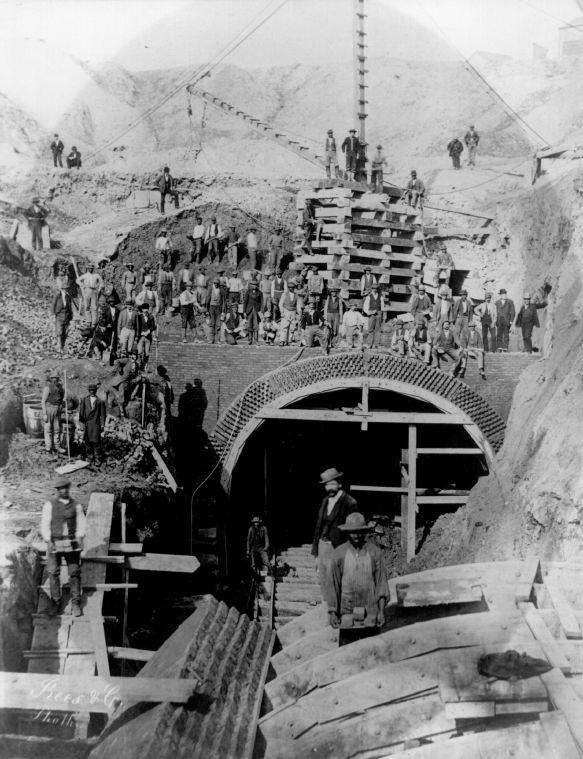
Figure 3.
Construction of the Church Hill railroad tunnel,
1872. This massive excavation project cut through the Richmond deposit of
diatomaceous earth, and provided C.L. Peticolas with substantial mounting
material.
During the early 1870s, a railroad tunnel was dug under Richmond that exposed large quantities of diatomaceous earth. Coryell’s 1876 paper on “The diatomaceous sands of Richmond, Virginia” acknowledged “C. Peticolas, microscopist” and stated that “The microscopic slides were prepared by Mr. C.L. Peticolas, from materials obtained from different localities, such as Church Hill, French Garden, the Capitol Grounds, etc. These localities yielded the most satisfactory and interesting specimens for the microscope, but failed to give the geological horizon or thickness of the strata
containing the diatoms. Mr. Peticolas, recognizing the importance and value of
the true position and thickness of the strata from a known base-line, very
kindly devoted his time to establish these facts for this paper, and, with the
knowledge and assistance of Major Channing M. Bolton, he was furnished with
material from well-established points in the tunnel and the railroad
excavations.”
The earliest known record of Peticolas’ involvement with microscopy is a testimonial from 1875 that was reprinted in advertisements (Figure 4). W.H. Walmsley congratulated Peticolas for his fine Richmond diatom slides. This suggests that Peticolas was at least dabbling with microscopy for some years prior to 1875.
Peticolas published his own paper on “The Richmond diatomaceous earth” in 1877, cleverly enhancing world-wide interest in those deposits and simultaneously advertising his products. Excerpts from his paper follow:
“The stratum of fossiliferous earth
underlying the cities of Richmond and Petersburg, in Virginia, when first
discovered by Professor Wm. B. Rogers in
1842, was supposed to be peculiar to those localities. The further
investigations of geologists have shown it to be a material constituent in
various parts of the great tertiary formation which bounds the continents of
North and South America, and, perhaps, those of the Eastern Hemisphere also.
The deposit at Richmond has long been famous with
micro-geologists for the great variety of beautiful forms it contains, the
illustrious Ehrenberg having assigned to it one hundred and twelve species - nearly
double the number to be found at any other place on the Atlantic coast; and the
subsequent researches of microscopists have shown it to be perhaps the richest
deposit of the kind in the world, every new preparation of the earth revealing
some forms not before noticed, many of the most interesting remaining unnamed or
described to the present day. The stratum varies in thickness from twenty to
forty feet; and Major Bolton, engineer of the Church Hill Tunnel, at Richmond,
(which pierces the deposit for three-fourths of a mile), informed me that at
certain points of that excavation it reached a maximum thickness of eighty
feet. In addition to an inexhaustible supply of the diatomaceous earth, that
work brought to light thousands of fossil remains of gigantic marine monsters,
that, long ages ago, swam in the deep ocean that must have covered the spot
where the city now stands.
Upon exposure for some time to the weather, this
earth assumes an almost snowy whiteness, and crumbles to a fine powder; but as
first dug from the depths of the earth, it resembles bituminous coal in color
and solidity—so tough and hard is it, that in removing it from the tunnel it
was blasted with gunpowder, just as any other rock. Its composition, as nearly
as can be estimated in a general way, is: 10 per cent unbroken forms of the
diatomaceae, 25 per cent fine white sand, and the balance fine clay, formed,
perhaps, mostly of the decomposed and broken diatoms - the whole mass
interspersed with many sponge spicules, and a few polycystina, and so strongly
impregnated with alum that many of the wells and springs in Richmond are
injured by it. To the microscopist this deposit is a source of unfailing
interest, whilst the most inexperienced in such matters, upon being shown the
wonderful forms found in it, are struck with surprise and delight. In looking at
these different forms, one is struck with the wonderful resemblance which they
bear to things of everyday use, as among them may be found models of almost all
the implements used by savages, whether for war, the chase, or in domestic
life; witness, for instance, his stone hatchets, arrow and spear heads, knotted
clubs, boomerangs, etc.; a catalogue of such matters used by civilized people
would embrace plates, dishes, cups, saucers, gridirons, pins, balls, tops,
spectacles, watches, anchors, dumb-bells, cannon, coin, musical notes, and many
other articles - the investigator being constantly startled by the strange
resemblance which hundreds of these ancient natural forms bear to articles used
in our houses and workshops. Certain varieties, however, predominate, and their
distribution varies with level and locality, the upper portion of the stratum
being comparatively poor in forms, while they increase in number and variety as
we descend to the middle, falling off again towards the bottom. The genus Coscinodiscus seems to characterize
this earth, and of it there are dozens of varieties varying from the
(microscopically) enormous C. Gigas to
the minute and elegant C. Subtilis, which
resembles closely a finely polished opal, requiring a lens of wide aperture and
considerable power to show its revelations. Orthisira Marina is abundant, whilst many beautiful forms of Navicula are found in every
gathering. Amongst these we may note two kinds of Pleurosigma, one of which, P. Angulatum, is a favorite test diatom, and the other, which it
is proposed to call P. Virginica (as
it is the most common form of Pleurosigma in the Virginia earths), is remarkable for the beauty of its contour,
which exactly copies a willow leaf, and the want of uniformity in its striae,
which are much coarser in the middle than at the ends of the valves. It is
easily resolved with a 1/4-inch objective, without the aid of oblique light.
The genus Triceratium is also well
represented by many beautiful varieties, the most interesting of which is T. Obtusum, which can be resolved
about as easily as P. Virginica.
Isthmia Enervis, Biddulphia Turmegii, Terpsinoe Musica, Aulocodiscus Crux,
Navicula Lyra, Gonphonema, Heliopelta, Asterolampra concinna, Asteromphalus
Brookeii and Synedra are comparatively rare.
From the great variety of its species, and the wide
range in the character of their markings, the Richmond earth forms one of the
best and most interesting tests for the performance of objectives of almost
every power. On some, for instance, the areolations may be seen with a simple
triplet, magnifying 25 linear; on others a first-class twelfth or sixteenth of
wide angular aperture, aided by all the modern refinements of illumination, is
needed to show them.
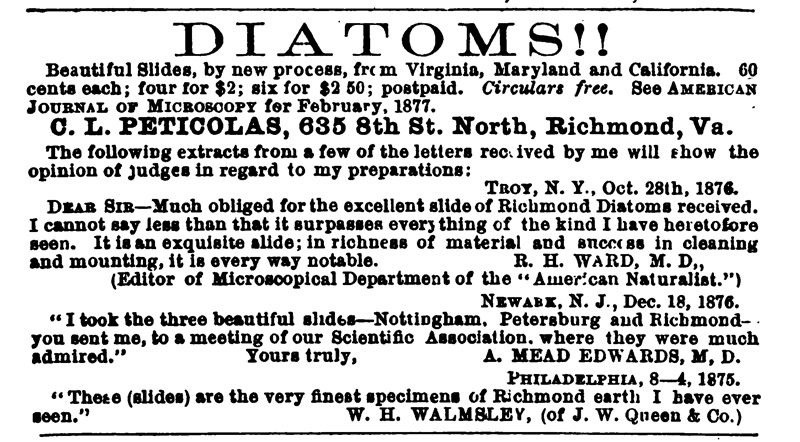
Figure 4.
1877 advertisement from Edwards, Johnston, and
Smith’s “Practical Directions for
Collecting, Preserving, Transporting, Preparing and Mounting Diatoms”
In
addition to Richmond diatoms, Peticolas rapidly acquired specimens of
diatomaceous deposits from around the world. The 1877 advertisement shown in
Figure 4 describes specimens from Maryland and California. The 1878 Transactions of the New York Microscopical
Society stated that, at that time, they had Peticolas mounts of diatoms
from Nottingham (Maryland), California, Petersburg (Virginia), Calvert County
(Maryland), Hanover (Virginia), Holland Cliff (Maryland), Lake Superior,
Drakesville (New Jersey), Toome Bridge (Ireland), and St. John's River
(Florida).
Also, by 1878, Peticolas had mastered skills to produce
arranged mounts of individual diatoms. The
Cincinnati Medical News wrote that year, “Mr. Peticolas prepares a ‘probe platte’, or
test slide, of nineteen diatoms, after the manner of Moller. On it are two or
three pleurosigmas, and an angulatum, a s. gemma, arachnodiscus Ehr., nav.
lyra, nytzchia, nav. crassinervis, etc.; the latter being the most difficult.
The p. angulata are said to be peculiar in that the striae on them all are
singularly uniform - not differing in their fineness. They are the more
valuable, therefore, as tests. We notice that the markings are finer than those
that come from Germany”. In 1885. C.S. Schultz exhibited to the New York
Microscopical Society a slide of, “Eighty-eight
Diatoms, arranged in three rows; mounted by Mr. Peticolas”.
Peticolas
also set his sights on the lucrative microscopy business in the British Isles.
In 1878, he sent the editors of the popular magazine Hardwicke’s Science-Gossip, “specimens of prepared diatoms, from parts
of the Richmond and Petersburg fields, lately discovered by me”, with additional comments that were sure to titillate diatom
aficionados, “A Navicula with curious
beading on the connecting zone, and very fine striation, is shown in tolerable
abundance, from four to six or more on each slide. This particular form, Prof.
H.L. Smith thinks new, and it is a very good test for a 1-8th or 1-10th
objective, which should resolve it into squares with oblique light. The
areolations on the larger Coscinodisci can be seen with a good simple triplet,
while to show the markings on some of the Rhizosolenia is a test for the very
best high powers. The two Richmond Pleurosigmas Virginica and angulatum, are
also plentiful, and as the striation on these is uniform, so far as my
observation goes, this slide makes one of the best general tests to be had,
furnishing an accurate measure for the comparison of objectives, of nature's
own ruling, perhaps superior to any artificial lines made”. The following
year, he sent four slides as gifts to the Royal Microscopical Society, by way
of Alfred Allen of the Postal Microscopical Society (thereby killing two birds
with one stone).
In 1880,
Peticolas announced that he was supplying a set of five slides that showed
different aspects of the Richmond deposit. He also produced multi-slide sets
from other deposits (Figure 5). The five Richmond slides consisted of:
“No. l is the natural cleavage, not quite a millimetre
in thickness, the growth of one season perhaps, mounted opaque, showing the
Diatoms abundantly in situ, just as they fell on the old ocean floor ages ago.
With binocular, this specially beautiful, although it may I be well seen with
monocular and any low power up to 4-10ths.
No. 2 is the natural deposit, dissolved in water, and
mounted in hard balsam, without treatment of any kind. The very small quantity
of sand contained enables one to draw the cover down close enough to obtain
fine views with the high powers. With these the great richness of this specimen
is well brought out, and it is exceedingly interesting as giving a clearer idea
of the composition of the deposit than any other preparation.
No. 3 is carefully washed without chemical treatment,
shows the Diatoms free from most foreign matters, and also such forms as are
usually destroyed by acids.
No. 4 is fully treated, most of the small forms and
broken fragments removed. It shows a great variety of Synedra not usually seen
on the Richmond slides from other localities, as well as all other forms
usually met with, in fine condition.
No. 5 is a separate mounting of the smaller forms,
suitable for 1/4 inch or higher powers. It is particularly rich in the more
uncommon species of the deposit, and has a great variety of them, on one small
experimental slide for instance, I have counted nearly 60 different species
(and) a number of other forms I was unable to classify, some of them very
curious, and undescribed in any work to which I have access”.
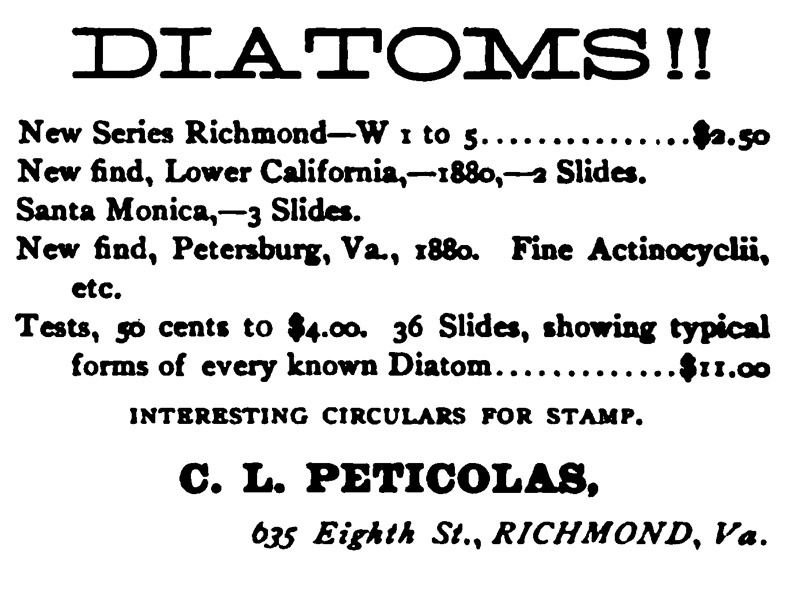
Figure 5.
An 1880 advertisement, from The American Monthly Microscopical Journal.

Figure 6.
By 1885, Peticolas’ Richmond series had grown to 12 slides.
In 1894,
Peticolas published a 24-page pamphlet and catalog, styled “The Diatom”, described as “Price 10 cents. Mr. Peticolas is well known as a microscopist and preparer of excellent slides of the
Diatomaceae. This little pamphlet contains some accounts of the Virginia and
New Jersey fossil deposits, with a catalogue of about 400
slides. The articles are reprinted from various microscopical journals”.
Peticolas wrote numerous journal articles on diatomaceous deposits, including
those reprinted in “The Diatom”.
In 1901,
Charles’ wife, Anna Marie, died. Her death coincided with a breakup of the
Peticolas household, although the reasons are unknown. The 1900 census recorded
71year-old Charles, 68 year-old Anna, and four of their children all living
together at 635 Eighth Street, but the 1910 census showed the widowed Charles without
family, boarding with a plumber in another part of town.
Shortly afterward, in 1914, Peticolas retired from
microscope slide making. He issued advertisements for a final sale, of which an
editor of The Guide to Nature wrote separately to the readers, “A
Faithful Microscopist. It is with especial interest that we call attention to
Mr. C. L. Peticolas' advertisement in which he offers his entire outfit in
microscopy. Mr. Peticolas is eighty-six years of
age. He has done more than any one else in this country to inspire an interest
in some of nature's most beautiful, yet quite commonly unknown objects - the
wonderful microscopic diatoms. To a large number of our readers, the word ‘diatom’ may be meaningless. Twenty years ago Mr. Peticolas inserted an advertisement in a journal edited
by the editor of this magazine and it brought liberal cash returns, for many
persons were then interested in diatoms, but diatoms are not things of the past.
Beautiful fossil forms exist in abundance and in almost every pool, especially
in the spring, myriads of these beautiful microscopic plants live and thrive.
If schools and nature lovers desire to secure beautifully mounted slides of
these beautiful objects, here is a good opportunity and at the same time to
assist this aged and deserving microscopist”.
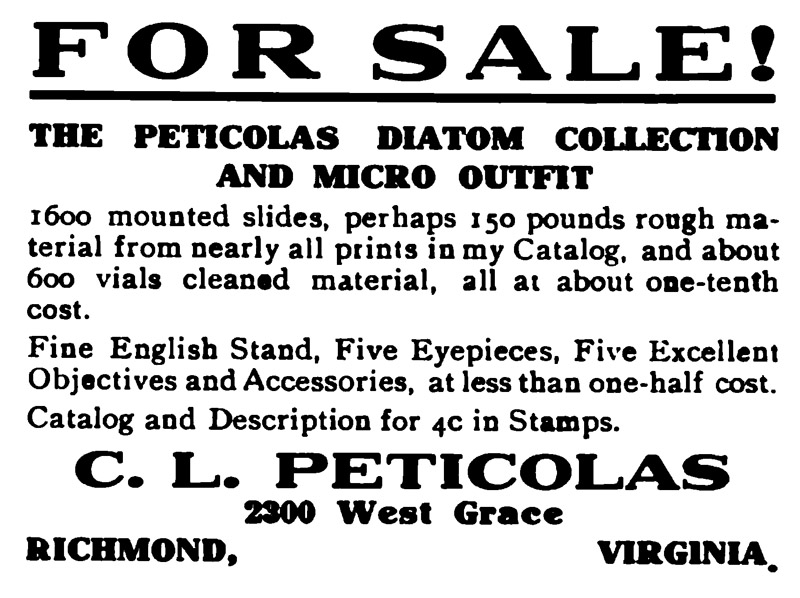
Figure 7.
1914 going-out-of-business advertisement.
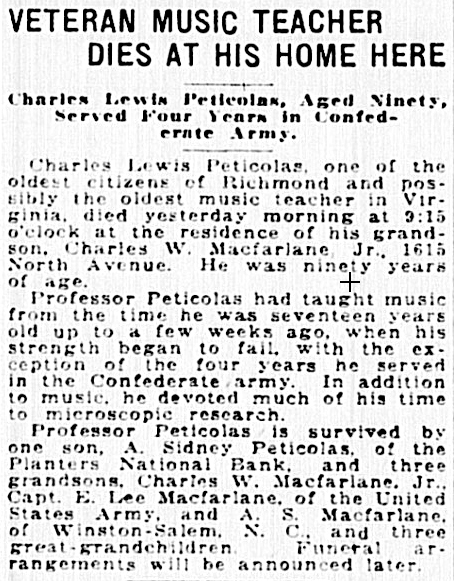
Figure 8.
Announcement of Charles L. Peticolas’ September 12, 1919 death. From the Richmond Times-Dispatch.
Resources
American Journal of Microscopy and Popular Science (1877) Richmond diatoms, Vol. 2, unnumbered page
American Journal of Microscopy and Popular Science (1878) Advertisement from C.L. Peticolas, Vol. 3, page 2
American Monthly Microscopical Journal (1880) Advertisement from C.L. Peticolas Vol. 1, September advertiser, page iv
American Monthly Microscopical Journal (1887) Advertisement from C.L. Peticolas, Vol. 8, December advertiser, page iii
American Monthly Microscopical Journal (1881) Exchange offer, “Wanted - good gatherings of Diatoms, fossil or recent, especially of test forms. Liberal exchange in fine slides; prepared or rough material. Lists exchanged. C.L. Peticolas, 635 8th Street, Richmond, Va.”, Vol. 2, page 160
American Naturalist (1876) The Richmond fossil earth, Vol. 10, page 753
Bracegirdle, Brian (1998) Microscopical Mounts and Mounters, Quekett Microscopical Club, London, pages 75 and 162, and plate 29-J and -K
Cincinnati Medical News (1878) Richmond diatomaceous earth, Vol. 7, pages 553-554
Coryell, Martin (1876) Diatomaceous sands of Richmond, Virginia, Transactions of the American Institute of Mining Engineers, Vol. 4, pages 230-232
The Guide to Nature (1914) A faithful microscopist, Vol. 7, page 415
The Guide to Nature (1914) Advertisement from C.L. Peticolas, Vol. 7, Advertisements page viii
Edwards, A. Mead, Christopher Johnston, Hamilton L. Smith, (1877) Practical Directions for Collecting, Preserving, Transporting, Preparing and Mounting Diatoms, The Industrial Publication Co., New York, advertisement from C.L. Peticolas at rear of book
Journal of the New York Microscopical Society (1885) Notes on the meeting of April 30, Vol. 1, page 122
Journal of the Royal Microscopical Society (1879) “Four slides of "Fossil Diatoms" from Richmond, Va., Petersburg, Va., and Nottingham, M.D. (U.S.), were presented by Mr. C.L. Peticolas, through Mr. A. Allen, the Secretary of the Postal Microscopical Society”, Vol. 2, page 219
Kendall Curlee, Kendall (2011, accessed September, 2014) Peticolas, Alfred Brown, Handbook of Texas Online. http://www.tshaonline.org/handbook/online/articles/fpe78
Johnson, Dale T. (1990) American Portrait Miniatures in the Manney Collection, Metropolitan Museum of Art, New York, pages 180-181
The Monthly Microscopical Journal (1877) The fossil earth of Richmond, U.S.A., Vol. 17, page 100
The Monthly Microscopical Journal (1877) The diatom earth of Richmond, U.S.A., Vol. 17, page 294
The Museum (1885) Advertisement from C.L. Peticolas, Vol. 1, page iii
The Observer (1894) Advertisements from C.L. Peticolas, Vol. 5, numerous issues
Peticolas, Alfred Brown (1984) Rebels on the Rio Grande: the Civil War journals of A.B. Peticolas,
edited by Don E. Alberts, University of New Mexico Press, Albuquerque, New
Mexico
Peticolas, C.L. (1878) The Richmond diatomaceous earth, The American Journal of Microscopy and Popular Science, Vol. 2, pages 17-18
Peticolas, C.L. (1878) Diatomaceous deposits near Richmond, Hardwicke’s Science-Gossip, Vol. 14, page 12
Peticolas, C.L. (1880) Some new slides from the Richmond, Virginia, diatomaceous earth, The American Journal of Microscopy and Popular Science, Vol. 5, pages 133-135
Peticolas, C.L. (1888) Notes on the diatomaceous formations of Virginia in connection with some recent discoveries made in the excavation of the Eighth Street Tunnel at Richmond, The Microscope, Vol. 8, pages 327-330
Peticolas, C.L. (1890) Notes on the fossil marine diatom deposit from artesian wells at Atlantic City, N. J., American Monthly Microscopical Journal, Vol. 11, pages 32-33
Peticolas, C.L. (1900) Diatoms of the James River Valley, Popular Science, Vol. 34, pages 189-190
Richmond Times-Dispatch (1872, accessed September, 2014) Photograph of construction of the Church Hill railroad tunnel, http://www.timesdispatch.com/multimedia/photos/news/church-hill-tunnel/collection_8c73d098-91f7-11e3-ae80-001a4bcf6878.html
Richmond Times-Dispatch (1919) Veteran music teacher dies in his home here, issue of September 13
Science (1880) The Richmond diatomaceous earth, Vol. 1, page 222
Scientific American (1894) New books and publications, Vol. 71, page 29
Stoutamire, Albert (1972) Music of the Old South: Colony to Confederacy, Associated University Presses, Cranbury, NJ, page 99
Transactions of the New York Microscopical Society (1878) Vol. 1, page 6
U.S.A. birth, marriage, military, death, and census records, accessed through ancestry.com
U.S. Library of Congress (accessed September, 2014) http://www.loc.gov







